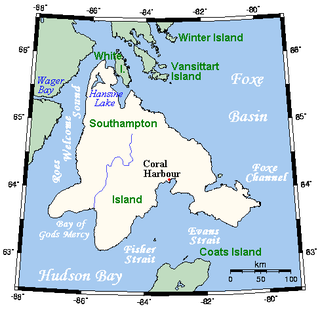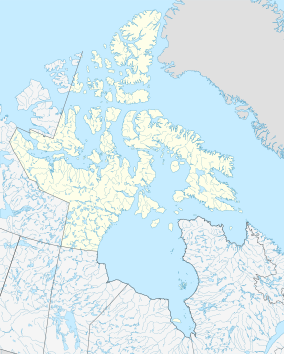Loading AI tools
The East Bay (Qaqsauqtuuq) Migratory Bird Sanctuary, Qaqsauqtuuq Migratory Bird Sanctuary,[1] or Refuge d'oiseaux de la baie Est[4] is a migratory bird sanctuary in the Kivalliq Region, Nunavut, Canada. It is located in East Bay, an arm of Hudson Bay, in southeast Southampton Island. The nearest community is Coral Harbour, 35 km (22 mi) to the west.[1]
| East Bay (Qaqsauqtuuq) Migratory Bird Sanctuary | |
|---|---|
| Location | Southampton Island, Kivalliq, Nunavut, Canada |
| Nearest town | Coral Harbour[1] |
| Coordinates | 64°N 82°W[2] |
| Area | 112,811 ha (1,128.11 km2; 435.57 sq mi)[1] |
| Established | 1959 |
It is one of two bird sanctuaries on the island, the other being the Harry Gibbons Migratory Bird Sanctuary, situated 193 km (120 mi) to the southwest.[5]
Established 1 January 1959, and consisting of 112,811 ha (1,128.11 km2; 435.57 sq mi)[1] it is rated Category IV by the International Union for Conservation of Nature. Of its 1,124 km2 (434 sq mi) in overall size, 286 km2 (110 sq mi) is a marine area with marine, intertidal, and subtidal components.[6]

Southampton Island has a severe subarctic climate (Köppen Dfc) which transitions into a tundra climate (ET). Like almost all of Nunavut, Southampton Island is entirely above the tree line. Coral Harbour has never gone above freezing in January, February and March (although the latter has recorded 0.0 °C (32.0 °F). Due to the frozen nature of Hudson Bay, there is a severe seasonal lag until June, especially compared to more continental areas such as Fairbanks despite much sunshine and perpetual twilight at night. Due to the drop of solar strength and the absence of warm water even in summer, temperatures still drop off very fast as September approaches. Cold extremes are severe, but in line with many areas even farther south in Canada's interior.
| Climate data for Coral Harbour (Coral Harbour Airport) WMO ID: 71915; coordinates 64°11′36″N 83°21′34″W; elevation: 62.2 m (204 ft); 1991–2020 normals, extremes 1933−present | |||||||||||||
|---|---|---|---|---|---|---|---|---|---|---|---|---|---|
| Month | Jan | Feb | Mar | Apr | May | Jun | Jul | Aug | Sep | Oct | Nov | Dec | Year |
| Record high humidex | 0.2 | −1.9 | −0.5 | 4.4 | 8.9 | 23.1 | 32.8 | 30.1 | 19.9 | 7.6 | 3.7 | 3.2 | 32.8 |
| Record high °C (°F) | 0.6 (33.1) |
−1.1 (30.0) |
0.0 (32.0) |
5.0 (41.0) |
9.4 (48.9) |
23.5 (74.3) |
28.0 (82.4) |
26.1 (79.0) |
18.5 (65.3) |
7.6 (45.7) |
4.0 (39.2) |
3.4 (38.1) |
28.0 (82.4) |
| Mean daily maximum °C (°F) | −24.9 (−12.8) |
−25.6 (−14.1) |
−20.2 (−4.4) |
−11.0 (12.2) |
−2.5 (27.5) |
6.9 (44.4) |
14.8 (58.6) |
12.1 (53.8) |
4.8 (40.6) |
−2.5 (27.5) |
−11.2 (11.8) |
−19.2 (−2.6) |
−6.5 (20.3) |
| Daily mean °C (°F) | −29.0 (−20.2) |
−29.7 (−21.5) |
−24.9 (−12.8) |
−16.1 (3.0) |
−6.0 (21.2) |
3.5 (38.3) |
10.2 (50.4) |
8.2 (46.8) |
2.0 (35.6) |
−5.5 (22.1) |
−15.5 (4.1) |
−23.4 (−10.1) |
−10.5 (13.1) |
| Mean daily minimum °C (°F) | −33.2 (−27.8) |
−33.7 (−28.7) |
−29.7 (−21.5) |
−21.1 (−6.0) |
−9.6 (14.7) |
0.1 (32.2) |
5.6 (42.1) |
4.2 (39.6) |
−0.8 (30.6) |
−8.6 (16.5) |
−19.8 (−3.6) |
−27.6 (−17.7) |
−14.5 (5.9) |
| Record low °C (°F) | −52.8 (−63.0) |
−51.4 (−60.5) |
−49.4 (−56.9) |
−39.4 (−38.9) |
−31.1 (−24.0) |
−15.6 (3.9) |
−1.1 (30.0) |
−3.3 (26.1) |
−17.2 (1.0) |
−34.4 (−29.9) |
−40.6 (−41.1) |
−48.9 (−56.0) |
−52.8 (−63.0) |
| Record low wind chill | −69.5 | −69.3 | −64.3 | −55.1 | −39.7 | −23.2 | −8.2 | −11.8 | −23.7 | −43.7 | −54.8 | −64.2 | −69.5 |
| Average precipitation mm (inches) | 9.5 (0.37) |
7.0 (0.28) |
11.2 (0.44) |
18.2 (0.72) |
19.0 (0.75) |
27.6 (1.09) |
34.1 (1.34) |
59.4 (2.34) |
45.4 (1.79) |
33.8 (1.33) |
22.9 (0.90) |
14.8 (0.58) |
302.9 (11.93) |
| Average rainfall mm (inches) | 0.0 (0.0) |
0.0 (0.0) |
0.0 (0.0) |
0.4 (0.02) |
4.3 (0.17) |
20.8 (0.82) |
34.1 (1.34) |
58.9 (2.32) |
36.7 (1.44) |
7.2 (0.28) |
0.5 (0.02) |
0.0 (0.0) |
163.0 (6.42) |
| Average snowfall cm (inches) | 9.6 (3.8) |
7.1 (2.8) |
11.3 (4.4) |
18.2 (7.2) |
14.9 (5.9) |
6.9 (2.7) |
0.0 (0.0) |
0.6 (0.2) |
8.6 (3.4) |
26.7 (10.5) |
22.9 (9.0) |
14.8 (5.8) |
141.6 (55.7) |
| Average precipitation days (≥ 0.2 mm) | 8.5 | 6.7 | 9.0 | 9.5 | 10.4 | 9.6 | 9.6 | 12.6 | 11.2 | 14.6 | 13.0 | 10.4 | 125.1 |
| Average rainy days (≥ 0.2 mm) | 0.0 | 0.0 | 0.0 | 0.2 | 1.8 | 7.2 | 9.6 | 12.5 | 8.2 | 3.6 | 0.6 | 0.1 | 43.8 |
| Average snowy days (≥ 0.2 cm) | 8.6 | 6.6 | 9.0 | 9.5 | 9.4 | 3.3 | 0.0 | 0.3 | 4.3 | 13.1 | 12.9 | 10.4 | 87.3 |
| Average relative humidity (%) (at 1500 LST) | 67.4 | 66.4 | 69.2 | 74.5 | 80.3 | 73.1 | 62.8 | 69.1 | 75.8 | 85.5 | 79.7 | 72.0 | 73.0 |
| Mean monthly sunshine hours | 37.9 | 112.1 | 187.4 | 240.2 | 239.9 | 262.2 | 312.3 | 220.4 | 109.8 | 70.8 | 47.9 | 18.8 | 1,859.7 |
| Percent possible sunshine | 22.4 | 47.0 | 51.6 | 53.2 | 42.0 | 41.9 | 51.2 | 43.3 | 27.9 | 23.3 | 24.3 | 13.9 | 36.8 |
| Source: Environment and Climate Change Canada[7] (rain/rain days, snow/snow days, precipitation/precipitation days and sun 1981–2010)[8] | |||||||||||||
The sanctuary's habitat consists of three main types, water, unvegetated land, and moist or wet vegetated tundra.[9] This can be further broken down as dry heath, gravel ridge, intertidal zone, moss carpet, scrub willow, and sedge meadow.[10]
A 1986 list of plants in the sanctuary found over 100 species of algae, fungi, lichens, bryophytes, and vascular plants.[11]
Plants found in the sanctuary include:[11]
- Arctic willow (Salix arcticus)
- Bigelow's sedge (Carex bigelowii)
- Creeping goose grass (Puccinellia phryganodes)
- Dark brown sedge (]Carex atrofusca)
- Hoppner's sedge (Carex subspathacea)
- Mountain avens (Dryas integrifolia)
- Prickly saxifrage (Saxifraga tricuspidata])
- Short-leaved sedge (Carex misandra)
- Snow willow (Salix reticulata])
- Wideleaf polargrass (Arctagrostis latifolia)
Bird species
Birds listed by the Committee on the Status of Endangered Wildlife in Canada (COSEWIC) or the Species at Risk Act (SARA) are noted as to their status.[12] Bird species include:[1][13][14]
- American golden plover (Pluvialis dominica)
- Arctic tern (Sterna paradisaea)
- Atlantic brant (Branta bernicla)
- Baird's sandpiper (Calidris bairdii)
- Bank swallow (Riparia ripariaTh)
- Barn swallow (Hirundo rusticaTh)
- Black guillemot (Cepphus grylle)
- Black-bellied plover (Pluvialis squatarola)
- Cackling goose (Branta hutchinsii)
- Canada goose (Branta canadensis)
- Common eider (Somateria mollissima)
- Dunlin (Calidris alpina)
- European herring gull (Larus argentatus)
- Harris's sparrow (Zonotrichia querulaScb)
- Ivory gull (Pagophila eburneaEn)
- King eider (Somateria spectabilis)
- Lesser snow goose (Anser caerulescens caerulescens)
- Long-tailed duck (Clangula hyemalis)
- Long-tailed jaeger (Stercorarius longicaudus)
- Northern pintail (Anas acuta)
- Pacific loon (Gavia pacifica)
- Parasitic jaeger (Stercorarius parasiticus)
- Peregrine falcon (Falco peregrinus)
- Purple sandpiper (Calidris maritima)
- Red knot (Rufa red knot, Calidris canutus rufaEn)
- Red phalarope (Phalaropus fulicarius)
- Red-necked phalarope (Phalaropus lobatusSc)
- Red-throated loon (Gavia stellata)
- Ross's goose (Anser rossii)
- Ross's gull (Rhodostethia roseaTh)
- Ruddy turnstone (Arenaria interpres)
- Sabine's gull (Xema sabini)
- Semipalmated plover (Charadrius semipalmatus)
- Short-eared owl (Asio flammeusSc)
- Tundra swan (Cygnus columbianus)
- Whimbrel (Numenius phaeopus)
- White-rumped sandpiper (Calidris fuscicollis)
Mammals
Mammals in the area are mainly Arctic fox (Alopex lagopus), Arctic hare (Lepus arcticus), brown (Lemmus sibiricus), and collared lemmings (Dicrostonyx groenlandicus). Barren-ground caribou (Rangifer tarandus) were reintroduced from Coats Island in 1967.Scb Wolves (Canis lupus), red foxes (Vulpes vulpes), and wolverines (Gulo guloSc) are occasionally sighted.[15]
Marine mammals include Atlantic walrus (Odobenus rosmarus rosmarusScb), bearded seal (Erignathus barbatus), beluga whale (Delphinapterus leucasScb), bowhead whale (Balaena mysticetusScb), harbor seal (Phoca vitulina), harp seal (Pagophilus groenlandicus), narwhal (Monodon monocerosScb), polar bear (Ursus maritimus), ringed seal (Pusa hispidaScb), walrus (Odobenus rosmarus).[11]
East Bay/Native Bay is a Canadian Important Bird Area (#NU023) and a Key Migratory Bird Terrestrial Habitat (NU Site 44).[14]
Wikiwand in your browser!
Seamless Wikipedia browsing. On steroids.
Every time you click a link to Wikipedia, Wiktionary or Wikiquote in your browser's search results, it will show the modern Wikiwand interface.
Wikiwand extension is a five stars, simple, with minimum permission required to keep your browsing private, safe and transparent.
